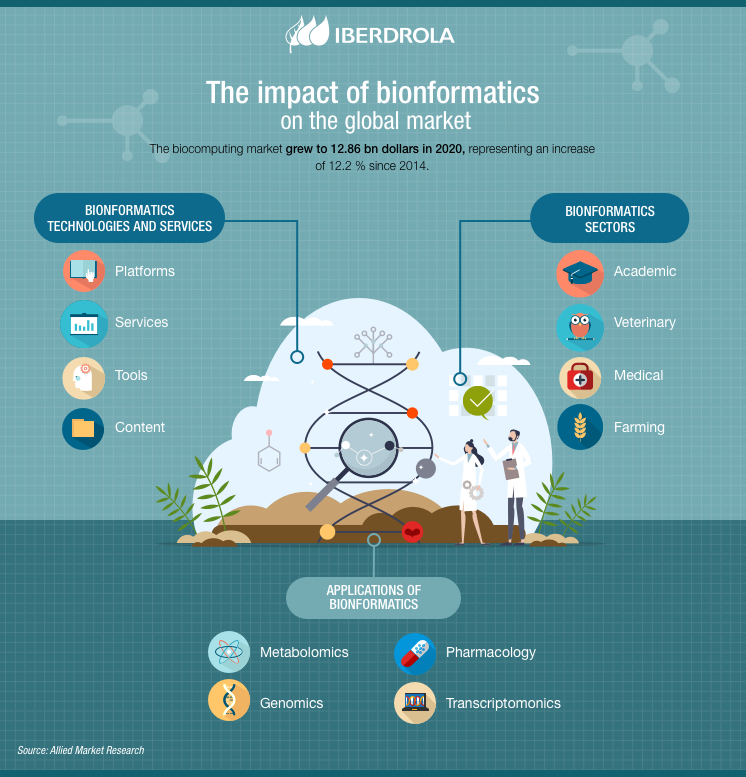Bioinformatics
What is bioinformatics and what is its impact on health?
Bioinformatics is helping to defeat the SARS-CoV-2 virus responsible for COVID-19. To understand how, it is useful to know a little more about this discipline, which is responsible for processing data from the field of biology by applying computer science. In other words, just as linguists study the patterns of language to preserve them, bioinformaticians study the patterns of DNA sequences and proteins to protect our health.

It has been calculated that in 2020, a total of 1.7 megabytes of data were created per second per person in the world, and it was processed thanks to techniques like big data. Although it seems incredible, the quantity of information contained in living organisms is not far behind. A person's DNA contains around 750 megabytes of information, just under a gigabyte, and extremely powerful computers and algorithms are needed to process this biological information. This is where bioinformatics comes in.
Bioinformatics, for example, has been crucial in the fight against the SARS-CoV-2 virus that causes COVID-19. In particular, computer analysis has made it possible to decipher the molecular structure of virus proteins in a way never before possible, allowing effective vaccines to be developed in record time to halt the spread of the virus.
WHAT DOES BIOINFORMATICS STUDY
According to the National Human Genome Research Institute (NHGRI), bioinformatics is a subdiscipline of biology and computing that serves to acquire, store, analyse and disseminate biological data, mostly DNA and amino acid sequences. For example, to study how normal cell activity is altered during an illness, it is necessary to combine data relating to numerous compounds and interpret the changes. This is especially true for proteins, the building blocks of life.
In the beginning, the term bioinformatics did not have the same meaning, as it was applied to the theoretical study of biological processes. However, advances in computing and data processing have made it possible to sequence more and more proteins automatically, culminating in a milestone: the sequencing of the human genome in 2004.
OBJECTIVES OF BIOINFORMATICS
These days, the most important part of bioinformatics is the analysis and interpretation of biological molecules, a process called computational biology. One might say, in fact, that bioinformatics is the linguistic side of genetics. The fundamental objectives are to identify genes and proteins, determine their functions, establish evolutionary relationships and predict their conformation.
Bioinformatics uses computing techniques that are applied in other fields, such as artificial intelligence, and which include pattern recognition, machine learning algorithms and data visualisation. It is also the current basis of biotechnology thanks to which it will be possible to develop more efficient drugs, genetic treatments and even progress in the fight against climate change, which makes the bioinformaticians a digital profile of the future.

WHAT DO BIOINFORMATICIANS DO
Bioinformatic scientists have to analyse large amounts of data at the molecular and genomic level. As part of their work, they must develop the necessary software to obtain these data and create new algorithms to interpret and adapt them to the needs of the project they are working on. They also create graphical visualisations of these data and their results.
In June 2021, a team of bioinformaticians presented the results which, through artificial intelligence, had allowed them to predict the structures of almost all the proteins made by the human body, more than 350,000 of them. This breakthrough is one of the most important in recent years and has enabled an enormous leap forward in our understanding of the body and the development of new drugs to treat diseases.
APPLICATIONS OF BIOINFORMATICS
Bioinformatics is a multidisciplinary field used in many life sciences, so it has numerous applications. Let's take a look at some of them:
 Medicine
Medicine
It has led to advances in personalised medicine, adapting treatments to each person's genetics.
 Pharmacology
Pharmacology
It has had a fundamental role in pharmaceutical research, particularly in combatting infectious diseases, and in developing vaccines.
 Genetics
Genetics
It is applied to gene therapy, particularly in illnesses caused by individual genes that have been affected or inherited. Likewise, the comparison of genomic data adds to our knowledge of the evolutional history of life on Earth.
 Agriculture
Agriculture
The use of proteomics, metabolomics and genetics allows stronger crops to be developed that are more resistant to drought and insect pests.
 Livestock
Livestock
It is used to sequence the genome of farm animals, prevent diseases and to give them more resistence and a better quality of life.
 Wastes
Wastes
It allows the DNA sequencing of bacteria and microbes to identify and evaluate their use in wastewater clean-up, radioactive waste disposal or plastics recycling.




